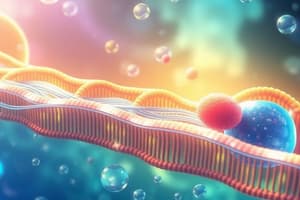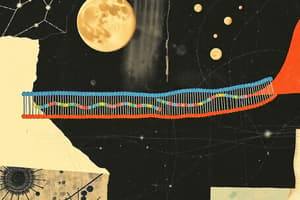Podcast
Questions and Answers
What is the purpose of active transport?
What is the purpose of active transport?
To speed up movement across the plasma membrane by expending ATP and moving solutes against their electrochemical gradient.
What are aquaporins involved in?
What are aquaporins involved in?
The diffusion of water.
What are ion channels?
What are ion channels?
Gated channels used to diffuse ions.
How do carrier proteins diffuse substances across the plasma membrane?
How do carrier proteins diffuse substances across the plasma membrane?
What is the difference between primary and secondary active transport? Explain.
What is the difference between primary and secondary active transport? Explain.
Give and explain three examples of primary active transport.
Give and explain three examples of primary active transport.
Identify four different factors that affect the rate of diffusion across a membrane.
Identify four different factors that affect the rate of diffusion across a membrane.
How does surface area affect the rate of diffusion across a membrane?
How does surface area affect the rate of diffusion across a membrane?
How does temperature affect the rate of diffusion across a membrane?
How does temperature affect the rate of diffusion across a membrane?
How does concentration affect the rate of diffusion across a membrane?
How does concentration affect the rate of diffusion across a membrane?
How are protein pumps specific?
How are protein pumps specific?
What kinds of proteins are ATPases?
What kinds of proteins are ATPases?
What does ATP stand for?
What does ATP stand for?
What substances can be transported by pumps that directly hydrolyze ATP?
What substances can be transported by pumps that directly hydrolyze ATP?
Describe how the sodium-potassium pump works.
Describe how the sodium-potassium pump works.
What is secondary active transport?
What is secondary active transport?
Where does the energy come from in secondary active transport?
Where does the energy come from in secondary active transport?
Describe glucose-sodium cotransport.
Describe glucose-sodium cotransport.
What is a uniport? Symport? Antiport?
What is a uniport? Symport? Antiport?
What is exocytosis?
What is exocytosis?
Flashcards are hidden until you start studying
Study Notes
Purpose of Active Transport
- Active transport speeds up movement across the plasma membrane by using ATP to move solutes against their electrochemical gradient.
Aquaporins
- Aquaporins facilitate the diffusion of water through the plasma membrane.
Ion Channels
- Ion channels are gated channels that allow the diffusion of ions across membranes.
Carrier Proteins
- Carrier proteins transport substances across the plasma membrane by undergoing conformational changes.
Types of Active Transport
- Primary active transport uses energy directly from ATP hydrolysis.
- Secondary active transport relies on energy stored in ion concentration gradients.
Examples of Primary Active Transport
- Sodium-potassium pump: Moves Na+ out and K+ into the cell by hydrolyzing ATP.
- Calcium pump: Transports calcium ions out of muscle cells after contraction.
- Proton pumps: Facilitate H+ secretion in the stomach and lysosomes.
Factors Affecting Diffusion Rate
- Distance, surface area, temperature, and concentration of solute influence how quickly diffusion occurs.
Surface Area Impact
- Increased surface area correlates with a higher rate of diffusion through membranes.
Temperature Impact
- Higher temperatures increase kinetic energy, leading to more molecular movement and collisions with the membrane.
Concentration Impact
- Greater solute concentrations prolong net movement as diffusion continues until equilibrium is reached.
Specificity of Protein Pumps
- Protein pumps each transport a specific substance, ensuring targeted movement.
ATPases
- ATPases are integral enzymes responsible for hydrolyzing ATP.
ATP Definition
- ATP stands for adenosine triphosphate, a key energy carrier in cells.
Substances Transported by ATP Hydrolyzing Pumps
- Positively charged ions like Na+, K+, Ca+, or H+ can be transported by these pumps.
Sodium-Potassium Pump Process
- The pump binds 3 Na+ ions from inside the cell and hydrolyzes ATP for phosphorylation.
- This conformational change allows Na+ release outside and the binding of 2 K+ from outside, which leads to dephosphorylation and a return to the original shape.
Secondary Active Transport
- Utilizes a transporter protein to couple the movement of an ion down its gradient with another molecule/ion moving against its gradient.
Energy Source in Secondary Active Transport
- Energy comes from the concentration gradient of the ion moving into the cell.
Glucose-Sodium Cotransport
- Both sodium and glucose move across the membrane simultaneously, with sodium providing energy for glucose transport without direct ATP use.
Transport Types
- Uniport: Transports one molecule in one direction.
- Symport: Transports two molecules in the same direction.
- Antiport: Transports two molecules in opposite directions.
Exocytosis
- Exocytosis is the process of secreting substances from the cell, involving vesicles that fuse with the plasma membrane.
Studying That Suits You
Use AI to generate personalized quizzes and flashcards to suit your learning preferences.



